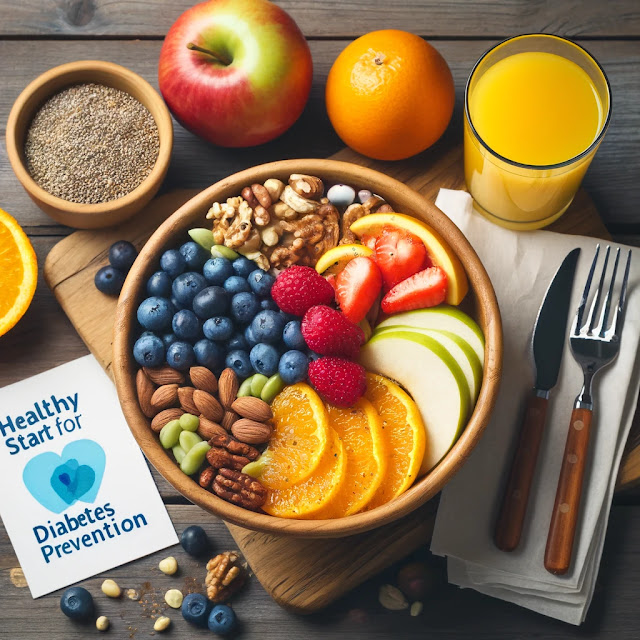Consuming Fruits and Vegetables: A Natural Approach to Reducing Diabetes Risk
Consuming Fruits and Vegetables: A Natural Approach to Reducing Diabetes Risk
Introduction
Diabetes
is one of the most prevalent chronic diseases worldwide, affecting millions of
people each year. It is primarily classified into Type 1 and Type 2 diabetes,
with Type 2 diabetes being the most common and largely preventable. Lifestyle
choices, particularly diet, play a crucial role in managing and reducing the
risk of diabetes. Among the various dietary interventions, increasing the
consumption of fruits and vegetables has been recognized as one of the most
effective ways to prevent diabetes.
Understanding Diabetes and Its Causes
Diabetes
is a metabolic disorder characterized by high blood sugar levels over a
prolonged period. The two main types of diabetes have different causes:
- Type 1 Diabetes: An autoimmune condition
where the body attacks insulin-producing cells in the pancreas.
- Type 2 Diabetes: A condition in which the
body either resists insulin or does not produce enough to maintain normal
glucose levels.
Several
risk factors contribute to the development of Type 2 diabetes, including
obesity, sedentary lifestyle, poor dietary choices, genetic predisposition, and
high stress levels. Among these factors, diet plays a crucial role in either
exacerbating or preventing diabetes.
The Role of Fruits and Vegetables in Diabetes
Prevention
Fruits
and vegetables are packed with essential nutrients, fiber, and antioxidants
that support overall health. Their consumption has been linked to lower risks
of developing Type 2 diabetes. Here’s how they contribute to diabetes
prevention:
1. High Fiber Content
Dietary
fiber is known for its ability to regulate blood sugar levels by slowing the
absorption of sugar into the bloodstream. High-fiber foods help in maintaining
stable glucose levels, reducing insulin spikes, and improving insulin
sensitivity. Vegetables like leafy greens, carrots, and bell peppers, as well
as fruits like apples, berries, and pears, are excellent sources of fiber.
2. Low Glycemic Index (GI)
The
glycemic index measures how quickly a food raises blood sugar levels. Fruits
and vegetables generally have a lower GI compared to processed foods and
refined carbohydrates. Consuming low-GI foods helps in preventing sudden blood
sugar spikes, making them an ideal choice for diabetes prevention. Examples of
low-GI fruits and vegetables include spinach, broccoli, cauliflower, oranges,
and berries.
3. Rich in Antioxidants
Antioxidants
such as vitamin C, vitamin E, and polyphenols found in fruits and vegetables
help reduce oxidative stress and inflammation, both of which contribute to
insulin resistance. Berries, citrus fruits, tomatoes, and dark leafy greens are
loaded with these essential antioxidants, making them powerful allies against
diabetes.
4. Weight Management
Obesity
is a major risk factor for diabetes, and consuming a diet rich in fruits and
vegetables can help with weight management. These foods are naturally low in
calories and high in water content, helping individuals feel full while
consuming fewer calories. This prevents excessive weight gain and reduces the
likelihood of developing diabetes.
5. Improved Gut Health
A healthy
gut microbiome plays a significant role in metabolic health. The fiber in
fruits and vegetables acts as a prebiotic, feeding beneficial gut bacteria that
help regulate blood sugar levels and reduce inflammation. A well-balanced gut
microbiome is linked to better insulin sensitivity and a lower risk of
diabetes.
Best Fruits and Vegetables for Diabetes Prevention
While all
fruits and vegetables offer health benefits, some are particularly effective in
reducing the risk of diabetes:
Best Vegetables:
- Leafy greens (spinach, kale,
Swiss chard)
- Cruciferous vegetables
(broccoli, cauliflower, Brussels sprouts)
- Carrots
- Bell peppers
- Tomatoes
- Cucumbers
Best Fruits:
- Berries (strawberries,
blueberries, raspberries)
- Apples (with skin)
- Pears
- Oranges
- Grapefruit
- Cherries
Tips for Incorporating More Fruits and Vegetables
into Your Diet
- Start your day with a fruit
smoothie:
Blend leafy greens, berries, and a banana for a nutritious breakfast.
- Add vegetables to every meal: Include a side salad or
stir-fried veggies with your lunch and dinner.
- Snack on fruits and
vegetables:
Instead of processed snacks, opt for sliced cucumbers, carrot sticks, or
an apple.
- Prepare healthy juices and
soups:
Freshly made vegetable juices and homemade soups are excellent ways to
increase intake.
- Try different cooking
methods:
Roasting, steaming, and grilling vegetables can enhance their flavors and
make them more enjoyable.
Conclusion
Diabetes
is a growing health concern, but its risk can be significantly reduced by
making simple dietary changes. Incorporating more fruits and vegetables into
daily meals can provide essential nutrients, regulate blood sugar levels, and
promote overall health. By adopting a balanced and plant-rich diet, individuals
can take a proactive step toward preventing diabetes and leading a healthier
lifestyle.






Post a Comment